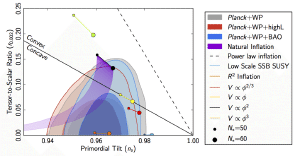Blog
Pruning the Tree
9 February 2015
 Planck Consortium
Planck ConsortiumWith all the brouhaha over the latest Planck satellite data and the revelation that the BICEP2 claim about early cosmic inflation didn’t hold up to scrutiny, it’s easy to imagine that all this work simply brings us back to where we started, with no idea of whether inflation is real, or just an incorrect model that happens to work. But in fact, the Planck results do tell us some things about inflation.1 It hasn’t validated the model, but it has pruned some limbs from the theoretical tree.
Inflation is a popular idea because it would solve several of the nagging mysteries of the universe. For example, when we look at the cosmic microwave background, we see it has a nearly uniform temperature. There are small scale fluctuations, but overall the temperature is too uniform. When the cosmic microwave background first appeared the observable universe was about 10 million light years across, but it was only about 380,000 years old, which isn’t nearly enough time for temperatures to even out. Inflation solves this problem by allowing the observable universe to be teeny tiny before expanding rapidly, which allows temperatures to even out before inflation.
Another issue is known as the flatness problem. If you average out all the curvature of space and time, both due to gravitational mass and cosmic expansion, we find that it adds up to zero to the limits of observation. In other words, the universe is flat. It seems odd that the universe would happen to be flat just by chance, but if early inflation occurred it would have flattened out the observable universe.
As an added bonus, inflation provides a mechanism for galaxies to cluster on the scale that we observe. Basically inflation would accentuate the gravitational clumping of matter in the early universe, allowing galaxies and clusters to form easily. It also resolves some issues in theoretical physics, such as the magnetic monopole mystery.
So inflation has a lot going for it, but the catch is that you can come of with lots of different mechanisms for inflation, and people have. There have been dozens of models proposed, and most of them fit the limited data we’ve had. But with Planck we can now start distinguishing between models. Assuming inflation to be true, we now know certain things.
For one, we know that it must have been adiabatic. That is, it must have occurred such that the ratio of electrons to photons must have remained fairly constant. This eliminates some of the more exotic models. We also know something about the inflation potential Φ, which governs the rate of inflation. Based on the data, inflation depending on Φ2 or higher powers are excluded.
There are still lots of variations that remain viable, but we aren’t searching in the dark any more. Even the models that are still in the game now have some limitations placed on them. This is where inflation begins to shift from a largely theoretical model towards an experimental one. Variations are now living or dying on the data.
Now we just have to keep pruning the tree.
Ade, Peter AR, et al. “Planck 2015 results-xiii. cosmological parameters.” Astronomy & Astrophysics 594 (2016): A13. ↩︎